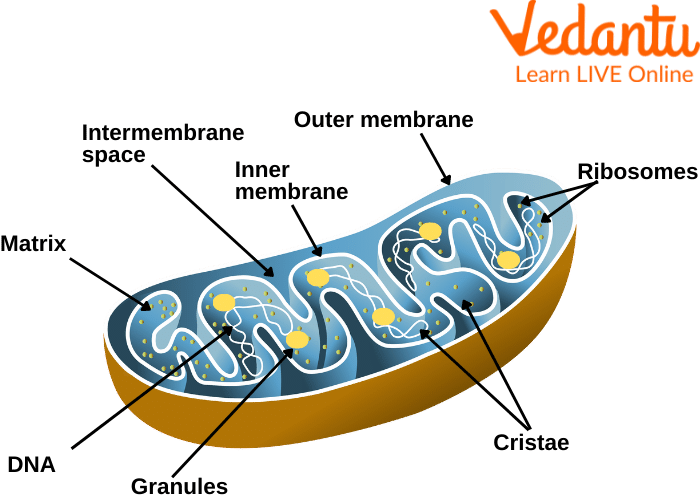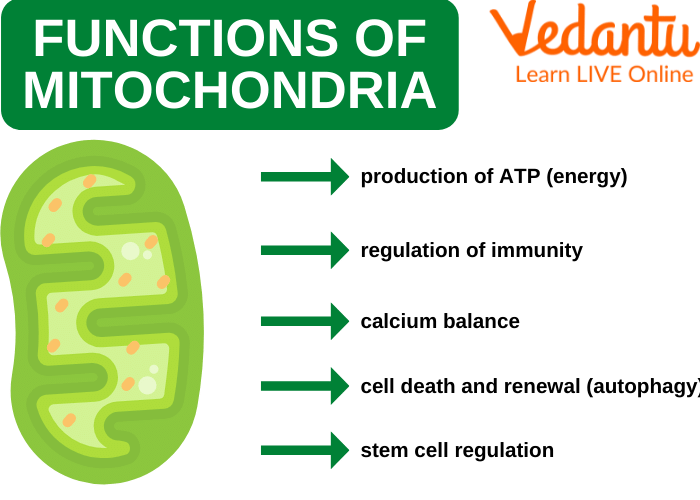




Why Are Mitochondria Known as the Powerhouse of the Cell?
We all eat our breakfast, dinner, and lunch, but have you ever wondered how we get energy from food? How can we use this energy? Well, it is due to mitochondria. Mitochondria are important cell organelles in our body and are known as the powerhouse of cells. Different types of cells have different numbers of mitochondria. For example, simple cells have one or two mitochondria, whereas complex cells, such as plant or animal cells, have numerous mitochondria as they require more energy.
Plant cells have hundreds of mitochondria, while the number goes to thousands and lakhs for animal cells. Interestingly, the human body has 1,00,000 to 6,00,000 mitochondria in each cell which can produce 90% of the energy in the body to perform daily tasks. In this article, we will discuss the mitochondria diagram, function of mitochondria, and structure of mitochondria.

Mitochondria
What Are Mitochondria?
Mitochondria are the powerhouse of cells as they generate energy for cell functioning. The structure of mitochondria is unique. The mitochondrion is a rod or sausage-shaped structure found in animal and plant cells. It is a small organelle whose size is between 0.5 to 1 micrometre in diameter. Hence, it cannot be seen under a microscope unless stained. Unlike other organelles, it has two layers; inner and outer. Each layer performs different functions.
Let us understand the structure with the mitochondria diagram.

Structure of Mitochondria
Mitochondria Structure
Outer Membrane - It is made of proteins. The membrane allows small protein-like molecules to pass through it.
Intermembrane Space - It is the space between outer and inner membranes.
Inner Membrane - This membrane is made of phospholipids and does not allow molecules to pass through it. Special transporters (carrier molecules) are required to transport substances. Here, ATP production takes place.
Cristae - These are the irregular folds of the inner membrane. They increase the space for chemical reactions to take place by increasing the surface area of the membrane.
Matrix - It is fluid within the inner membrane. This fluid has several enzymes required for ATP production. It also contains ribosomes, mitochondrial DNA, inorganic and organic molecules, etc.
What is the Function of Mitochondria?
The most common function of Mitochondria is energy generation. However, it performs several other vital functions of the body. These include the following.

Mitochondria Functions
Energy Generation
Mitochondria help produce ATP molecules which are the energy units of cells. Most energy production takes place in the cristae or folds of the inner membrane. It generates energy by converting chemical energy from food.
Cell Death
Apoptosis or cell death is an essential part of the regeneration of new cells. As cells damage or become old, they are destroyed by the mitochondria, and new cells are formed. It releases enzymes like Cytochrome C, which helps in cell degeneration.
Heat Production
In extreme colds, the body generates its heat by utilising tissue fat. Mitochondria release energy in the form of heat in cold climatic conditions.
Storing Calcium
Calcium is involved in several cellular processes. For example, releasing neurotransmitters for nerve conduction and muscle movement, blood clotting, fertilisation, hormone signalling, steroid synthesis, and cellular metabolism. As calcium is so important for the body, cells regulate it tightly. Mitochondria help in the absorption of calcium ions and store them until they are used.
Some More New Things About Mitochondria
Mitochondria are the powerhouse of cells and produce energy.
It has a complex structure, and each performs distinct functions.
Like a nucleus, it has its DNA.
The outer membrane of the mitochondria has a protein called porins which forms protein channels to facilitate molecule transport.
Mature red blood cells have no mitochondria.
Liver cells have more than 2,000 mitochondria.
It has dividing and multiplying abilities.
In human sperm, mitochondria are spiral-shaped and provide energy for motion.
Summary
Mitochondria are popularly known for their ability to generate energy. They are a double membrane organelle and have a typical structure and are called the powerhouse of a cell. They carry numerous bodily functions and metabolic activities, including heat generation, apoptosis, neurotransmitter regulation, calcium uptake, etc. Interestingly, they have their DNA while other cell organelles do not possess DNA.
Changes in the mitochondrial DNA can lead to insufficient ATP or energy production and other critical diseases. The number of mitochondria varies from cell to cell or organism to organism. For example, human liver cells have more than 2000 mitochondria, whereas human red blood cells have no mitochondria. In the end, we have seen some facts about mitochondria. If there are any doubts related to the topic please ask in the comments.
FAQs on Mitochondria Explained: Definition, Structure & Role
1. What is the primary function of mitochondria in a cell?
The primary function of mitochondria is to carry out cellular respiration. Through this process, they convert chemical energy from nutrients like glucose into adenosine triphosphate (ATP), which serves as the main energy currency for almost all cellular activities. This vital role is why mitochondria are commonly known as the 'powerhouse of the cell'.
2. What are the main parts that make up a mitochondrion's structure?
A mitochondrion has a distinct double-membrane structure. Its main components are:
- Outer Membrane: A smooth, permeable membrane that encloses the entire organelle.
- Inner Membrane: A less permeable membrane that is extensively folded into shelf-like structures called cristae.
- Cristae: These folds significantly increase the surface area for ATP synthesis.
- Matrix: The gel-like fluid within the inner membrane. It contains mitochondrial DNA (mtDNA), ribosomes, and various enzymes required for the Krebs cycle.
3. Why does the number of mitochondria vary between different types of cells?
The number of mitochondria in a cell is directly related to its metabolic activity and energy requirements. Cells with high energy demands, such as heart muscle cells (which can have up to 5,000 mitochondria) and liver cells, are packed with them to produce sufficient ATP. In contrast, cells with lower energy needs, like skin cells, have significantly fewer.
4. Why is the inner mitochondrial membrane folded into cristae?
The folding of the inner membrane into cristae is a critical structural feature that maximizes energy production. This design vastly increases the surface area available for the protein complexes and enzymes involved in the electron transport chain and oxidative phosphorylation. A larger surface area allows the cell to synthesise a much greater amount of ATP, making energy generation highly efficient.
5. What makes mitochondria unique as semi-autonomous organelles?
Mitochondria are considered semi-autonomous because they possess their own circular DNA (mtDNA) and ribosomes (70S type), similar to prokaryotes. This allows them to synthesise some of their own proteins and replicate independently of the cell's nuclear division through a process resembling binary fission. However, they are not fully independent, as they rely on proteins encoded by the cell's nuclear DNA for many of their functions.
6. What is the significance of mitochondria having their own DNA from an evolutionary perspective?
The presence of mitochondrial DNA (mtDNA) provides strong evidence for the endosymbiotic theory. This theory proposes that mitochondria evolved from ancient free-living prokaryotes that were engulfed by a larger ancestral host cell. Instead of being digested, they formed a symbiotic relationship, with the prokaryote providing ATP and the host cell providing nutrients and protection. The mtDNA is a remnant of this ancestral prokaryote's genome.
7. Beyond generating energy, what are some other important functions of mitochondria?
While famous for ATP synthesis, mitochondria have several other crucial roles in the cell. These secondary functions include:
- Calcium Homeostasis: They help regulate the concentration of calcium ions in the cytoplasm, which is vital for cell signalling and muscle contraction.
- Programmed Cell Death: Mitochondria play a key role in initiating apoptosis by releasing specific proteins like cytochrome c.
- Heat Production: In certain cells, they can generate heat in a process called non-shivering thermogenesis.
- Metabolic Synthesis: They are involved in the synthesis of certain steroids and heme groups for haemoglobin.
8. What are mitochondrial diseases and why do they occur?
Mitochondrial diseases are a group of disorders caused by the malfunctioning of mitochondria, often due to mutations in either the mitochondrial DNA (mtDNA) or the nuclear DNA that codes for mitochondrial components. Because mitochondria are present in nearly every cell, these diseases can affect various parts of the body, particularly organs with high energy needs like the brain, heart, and muscles. Symptoms can include muscle weakness, dementia, diabetes, and learning disabilities.









